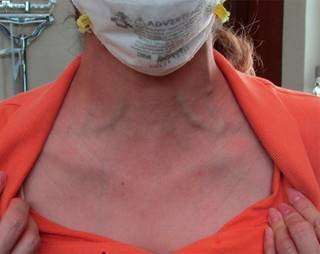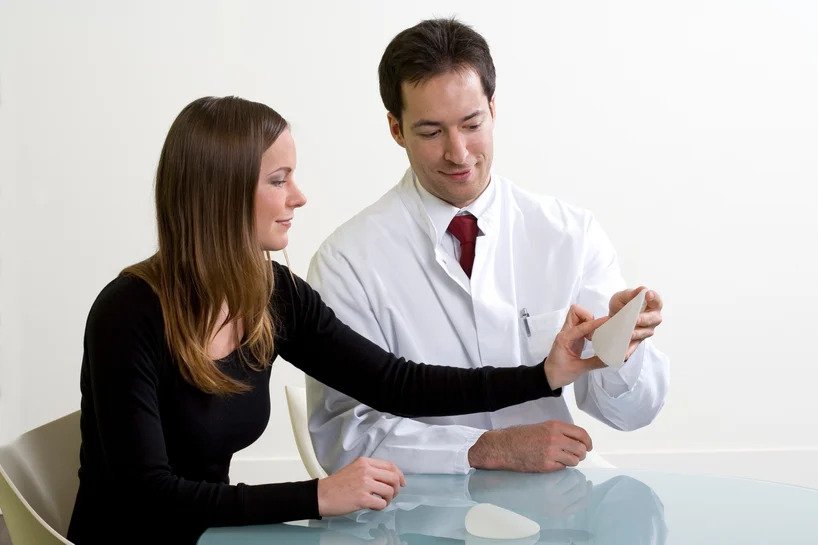Autoimmune syndrome induced inflammatory adjuvants (ASIA): a syndrome of Shoenfeld
Autoimmune/inflammatory syndrome induced by adjuvants (ASIA): Shoenfeld''s syndrome
Luis Gerardo Domínguez Carrillo1 * José Gregorio Arellano Aguilar2
1 Professor of the Faculty of Medicine of Leon, University of Guanajuato. Mexico
2 Internist. Division of Medicine of the Hospital Angeles Leon. León, Guanajuato, Mexico.
Introduction:
The autoimmune syndrome induced inflammatory adjuvants is an entity described in 2011. Its manifestations include myalgia, arthralgia, chronic fatigue, and dry mouth, as well as neurological manifestations: cognitive impairments, memory loss, and neurological disabilities.
Clinical case:
40 year old woman with breast implants of 20 years, that in the last six months, has been presented: myalgia, fatigue, feeling of stiffness and arthralgia widespread, including cervical and lumbar spine, difficulty to concentrate on your work and sleep disturbances, changes in mood with irritability and shortness of breath when climbing stairs, thereby increasing the fatigue mainly in the pelvic limbs. Laboratory studies relevant showed insufficiency of vitamin D, elevated C-reactive protein and erythrocyte sedimentation rate (ESR) increased; mammography reported contractures type II Baker. Was removal of breast prostheses, and prescription of vitamin D, to six months of the postoperative period, patient asymptomatic doing aerobic exercise five days a week.
Conclusion:
Silicone breast implants can produce the syndrome of ASIA in patients immunologically susceptible.
Key words: Autoimmune syndrome by adjuvants; breast; silicone
Introduction:
Adjuvant-induced inflammatory autoimmune syndrome is an entity described in 2011. Sti manifestations include myalgias, arthralgias, chronic fatigue and dry mouth, as well as neurological manifestations: cognitive alterations, memory loss and neurological disabilities.
Clinical case:
40-year-old female, with breast prostheses for 20 years, who in the last six months have you presented: myalgias, fatigue, sensation of joint stiffness and generalized arthralgias, including cervical and lumbar spine, difficulty concentrating at work and sleep disturbances, mood changes with irritability and dyspnea when climbing stairs, increasing fatigue mainly in the pelvic extremities. Relevant laboratory studies showed vitamin D insufficiency, elevated C-reactive protein and increased erythrocyte sedimentation rate (ESR); mammography reported Baker's type II contractures. Breast prosthesis was removed and vitamin D was prescribed, six months postoperatively, the patient was asymptomatic and underwent aerobic exercise five days a week.
Conclusion:
Silicone implants can occur ASIA syndrome in immunologically susceptible patients.
Keywords: Adjuvant autoimmune syndrome; breast prosthesis; silicone
Introduction
The autoimmune syndrome induced inflammatory adjuvants (ASIA, for its acronym in English) is an entity described by Shoenfeld1 and co-workers in 2011. It constitutes a group of diseases mediated by immune mechanisms, which share a clinical picture of common, as well as the history of prior exposure to an agent adjuvant (a substance capable of increasing the immunogenicity of an antigen without awakening a response per se). This phenomenon immune has been reported in four entities are: 1) syndrome miofascitis macrophagic (MMF); 2) phenomenon postvacunación; 3) syndrome of the Gulf war (SGG); and 4) siliconosis.2 It is believed that the phenomena of post-vaccination and the MMF develop mainly after the use of adjuvants based on aluminium, while the incidence of SGG is due to exposure to the adjuvant squalene. From the clinical point of view, patients with ASIA having myalgia, arthralgia, chronic fatigue, and dry mouth, as well as neurological manifestations such as cognitive impairment, memory loss, and neurological disabilities. The pathogenesis of these conditions involves an interaction multifactorial between environmental factors and genetic predisposition, and there is association with certain haplotypes of the major histocompatibility complex. Since its emergence as a disease entity, have been reported more than 4,000 documented cases of the syndrome ASIA with diverse clinical severity and diverse backgrounds of exposure to an adjuvant. Given that in the world of breast implants are very frequent, it is important to remember that these are not safe and can cause problems, which may go unnoticed or confuse the clinician. When presented with a patient with the symptoms mentioned above, will the filing of the case, considering that it may be important for the general practitioner, the ob / gyn, the rheumatologist and the plastic surgeon have in mind for the syndrome of ASIA.

Clinical case
40 year old woman, with a history of implantation of breast prostheses 20 years ago. No history of importance. Go to query by presenting a clinical picture of six months of evolution, characterized by myalgia and generalized fatigue, sensation of stiffness and arthralgia widespread, including cervical and lumbar spine, mainly morning with a duration of 30 to 40 minutes, difficulty to concentrate on your work and disturbed sleep, waking up too often. In the last two months were added changes in mood with irritability and shortness of breath when climbing stairs, thereby increasing the fatigue mainly in the pelvic limbs. The exploration, the data to call attention were: heart rate (HR) 85 lat./min; respiratory rate (rr) 18 resp./min; blood pressure (bp) 110/60 mmHg; weight 62 kg, height 167 cm; body mass index (BMI) 22.2. Neck with engorgement of venous noticeable (Figure 1), thyroid not palpable, arcs of motion cervical normal with the presence of moderate pain to carry them out, spasm of paravertebral cervical, trapezius and upper angle of the scapula bilaterally, the absence of trigger points, presence of axillary lymph nodes increased in size, moderately painful. Lumbar spine with increased muscle tone in lumbar paraspinal, with arches of mobility normal to moderately painful to the flexoextensión, and the absence of trigger points; tips chest with clinical examination of muscle with a rating of 5/5 in scale Daniels, but with a feeling of fatigue against contraction resisted. Reflections osteotendinosos, sensitivity, and capillary refill normal.

Figure 1: Photo clinic for 40 year old woman with engorgement of venous noticeable at rest and without Valsalva manoeuvres.
We considered the following diagnostic possibilities: 1) fibromyalgia, 2) hypothyroidism, 3) rheumatoid arthritis, 4) syndrome of ASIA (by mammary prosthesis) and (5) heart disease to rule out. Within the results of laboratory highlighted: hydroxyvitamin D in 12.66 ng/mL; C-reactive protein 15 mg/dL; erythrocyte sedimentation rate in 49 mm, remaining within the normal parameters. The chest radiography and echocardiography were normal. The mammogram showed contractures type II Baker (Figure 2), and ultrasound breast, reported ganglia increased volume level axillary.
Figure 2: A, (B) Images of bilateral mammography showing both breasts classified as BI-RADS-2, and the presence of breast implants, with contractures type II Baker. C, D) Ultrasound images at the level axillary, showing increase bilateral size of two axillary lymph nodes.
We arrived at the diagnosis of syndrome of ASIA by presenting at least four major criteria (myalgias, arthralgias, fatigue and sleep disturbances). It was explained to the patient the diagnosis, as well as the relationship between the silicone of the prosthesis and its symptoms, and what determined the removal of the prosthesis by the Department of Plastic Surgery, as well as the administration of vitamin D. The evolution was favourable, appearing asymptomatic at six months post-surgery, doing aerobic exercise five days a week, with control hydroxyvitamin D within normal parameters.
Discussion
Adjuvants are molecules that work by enhancing the specific immune responses to the antigen, in and of themselves do not generate an immune response, helps in the production of a significant reaction against their antigens inoculated. In general, adjuvants influence both the adaptive immunity as innate, activating pattern recognition receptors, specifically in the Toll-like receptor (TLR) receptors of type NOD and the lectin receptors of type C, leading to the recruitment and activation of proteins and generation of cytokines; promote the chemotaxis of dendritic cells and activation of antigen presenting cells, increasing the transfer of antigens to the areas with abundant B cells and T.2 In genetically susceptible individuals, exposure of adjuvants can induce musculoskeletal symptoms constitutional generalized nonspecific, and may lead to the production of autoantibodies and the induction of autoimmune diseases.3
The report Fryzek4 and co-workers showed statistically significant results (RR variation of 1.2 to 1.4, with a confidence interval of 95%) in relation with the constitutional symptoms and rheumatologic symptoms in 1,546 patients with silicone implant, in comparison with 2,496 controls; these findings are consistent in the possible relationship between the silicone implant and the grouping of these symptoms, constituting the syndrome ASIA. Another factor involved is the low level of vitamin D associated with the development of autoimmunity, including development of antibodies, a situation that is enhanced if it is associated with the presence of silicone,5 suggesting the possible benefit of the immunomodulatory action of vitamin D in the prevention of the subsequent formation of antibodies in these patients.
Conclusions
The patients with syndrome of ASIA with silicone implants that possess certain haplotypes, genetic, including HLA-DR5 and HLA-DQ2, are more likely, and a willingness to present the box, so that it is justified to remove the silicone implants when the patients experiencing this type of clinical manifestations.
Conclusions
Patients with ASIA syndrome with silicone implants who possess certain genetic haplotypes, including HLA-DR5 and HLA-DQ2, are more likely and predisposed to develop the condition, so removal of silicone implants is justified when patients present with these types of clinical manifestations.
Written by Dr. Luis Gerardo Dominguez Carrillo
April 14, 2021
Original Source: https://www.scielo.org.mx/scielo.php script=sci_arttext&pid=S1870-72032022000100096





